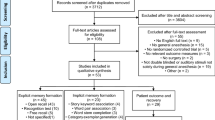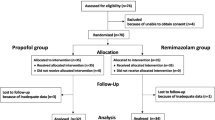Abstract
Rationale:
Placebo-controlled studies show that midazolam impairs explicit memory in children undergoing surgery (Buffett-Jerrott et al., Psychopharmacology 168:377–386, 2003; Kain et al., Anesthesiology 93:676–684, 2000). A recent within-subjects study showed that midazolam impaired explicit memory while leaving implicit memory intact in a sample of older children undergoing painful medical procedures (Pringle et al., Health Psychol 22:263–269, 2003).
Objectives:
We attempted to replicate and extend these findings in a randomized, placebo-controlled design with younger children undergoing surgery.
Materials and methods:
Children aged 3–6 years who were undergoing ear tube (myringotomy) surgery were randomly assigned to receive midazolam (n=12) or placebo (n=11). After surgery, they were tested on explicit (recognition) and implicit (priming) memory for pictures encoded before surgery.
Results:
Relative to placebo, the midazolam-treated children showed poorer recognition memory on the explicit task but equivalent priming on the implicit task.
Conclusions:
Overall, it appears that midazolam induces a dissociation between explicit and implicit memory in young children in the pediatric surgery setting. Theoretical and clinical implications of the findings are discussed along with directions for future research.


Similar content being viewed by others
Notes
Because Levene’s test for equality of variances showed that the equal variance assumption was violated in the case of commission errors on the PDTP (see Table 1), we also compared the two drug groups on this baseline variable using a non-parametric test—specifically, the Mann–Whitney U test. This test confirmed that there were no significant differences between groups on this variable at baseline (Z=−0.736, n.s.).
Given concerns about possible violations of the assumption of equal variances required for ANOVA (see Tables 1 and 2), we also analyzed the variables derived from the PDTP and MDT using non-parametric tests. Wilcoxon signed-ranks tests for dependent samples (Daniel 1978) were specifically used to compare pre- and post-drug performance on each of the six dependent measures in each drug group separately. One-tailed tests were used as directional predictions had been made a priori. These non-parametric tests produced a nearly identical pattern of findings to those reported for the ANOVAs in the main body of the paper. As observed with the ANOVAs, significant effects of drug phase were observed with the Wilcoxon tests for: attention speed in the midazolam group (Z=−1.726, p<0.05), number of omissions on the MDT in the midazolam group (Z=−1.992, p< 0.05), psychomotor speed in the midazolam group (Z=−2.667, p<0.005), and psychomotor speed in the placebo group (Z=−1.784, p<0.05). The Wilcoxon tests revealed an additional significant effect of drug phase for commission errors on the attentional test in the midazolam group (Z=−1.890, p<0.05). In each case, performance was worse at post-drug than at pre-drug baseline.
References
Buffett-Jerrott SE, Stewart SH (2002) Cognitive and sedative effects of benzodiazepine use. Curr Pharm Des 8:45–58
Buffett-Jerrott SE, Stewart SH, Finley GA, Loughlan HL (2003) Effects of benzodiazepines on explicit memory in a paediatric surgery setting. Psychopharmacology 168:377–386
Bullock-Drummey A, Newcombe N (1995) Remembering versus knowing the past: children’s explicit and implicit memories for pictures. J Exp Child Psychol 59:549–565
Chen E, Zeltzer LK, Craske MG, Katz ER (2000) Children’s memories for painful cancer treatment procedures: implications for distress. Child Dev 71:933–947
Clarke R, Morton J (1983) Cross modality facilitation in tachistoscopic word recognition. Q J Exp Psychol A Human Exp Psychol 35:79–96
Cole WHJ (1982) Midazolam in paediatric anaesthesia. Anaesth Intensive Care 10:36–39
Corkum V, Byrne JM, Ellsworth C (1995) Clinical assessment of sustained attention in preschoolers. Child Neuropsychol 1:3–18
Curran HV (1986) Tranquilizing memories: a review of the effects of benzodiazepines on human memory. Biol Psychol 23:179–213
Daniel WW (1978) Applied non-parametric statistics. Houghton Mifflin, Boston, MA
DeJong PC, Verburg MP (1988) Comparison of rectal to intramuscular administration of midazolam and atropine for premedication of children. Acta Anaesthesiol Scand 32:485–489
Feld LH, Negus JB, White PF (1990) Oral midazolam preanesthetic medication in pediatric outpatients. Anesthesiology 73:831–834
Fenson L, Dale PS, Reznick JS, Bates E, Thal DL, Pethick SJ (1994) Variability in early communicative development. Monogr Soc Res Child Dev 59:1–173
Finley GA, Stewart SH, Buffett-Jerrott S, Wright KD, Millington D (2006) High levels of impulsivity may contraindicate midazolam premedication in children. Can J Anaesth 53:73–78
Friedman AG, Mulhern RK, Fairclough D, Ward PM, Baker D, Mirro J, Rivera GK (1991) Midazolam premedication for pediatric bone marrow aspiration and lumbar puncture. Med Pediatr Oncol 19:499–504
Giebink GS, Daly K (1990) Epidemiology and management of otitis media in children. Top Lang Disord 11:1–10
Graf P, Schacter DL (1985) Implicit and explicit memory for new associations in normal and amnesic subjects. J Exp Psychol 11:501–518
Green DM, Swets JA (1966) Signal detection theory and psychophysics. Wiley, New York
Greenbaum JL, Graf P (1989) Preschool period development of implicit and explicit remembering. Bull Psychon Soc 27:417–420
Kain ZN, Mayes LC, O’Connor TZ, Cicchetti DV (1996) Preoperative anxiety in children: predictors and outcomes. Arch Pediatr Adolesc Med 150:1238–1245
Kain ZN, Mayes LC, Bell C, Weisman S, Hofstadter MB, Rimar S (1997) Premedication in the United States: a status report. Anesth Analg 84:427–432
Kain ZN, Hofstadter MB, Mayes LC, Krivutza DM,Alexander G, Wang S, Reznick JS (2000) Midazolam: effects on amnesia and anxiety in children. Anesthesiology 93:676–684
Korkman M, Kirk U, Kemp S (1997) Manual for the NEPSY: a developmental neuropsychological assessment. The Psychological Corporation, New York
Kupietzky A, Holan G, Shapira J (1996) Intranasal midazolam better at effecting amnesia after sedation than oral hydroxyzine: a pilot study. Pediatr Dent 18:32–34
Laycock GJA, McNicol LR (1988) Hypoxamia during induction of anaesthesia—an audit of children who underwent general anaesthesia for routine elective surgery. Anaesthesia 43:981–984
McGuire KA (2003) Developmental changes in children’s implicit and explicit memory abilities from 3 to 5 years of age. Undergraduate honors thesis, Department of Psychology, Dalhousie University
Naito M (1990) Repetition priming in children and adults: age-related dissociation between implicit and explicit memory. J Exp Child Psychol 50:462–484
O’Boyle CA, Barry H, Fox E, Harris D, McCreary C (1987) Benzodiazepine-induced event amnesia following a stressful surgical procedure. Psychopharmacology 91:244–247
Payne KA, Coetzee AR, Mattheyse FJ (1991) Midazolam and amnesia in pediatric premedication. Acta Anaesthesiol Belg 42:101–105
Pringle B, Dahlquist LM, Eskenazi A (2003) Memory in pediatric patients undergoing conscious sedation for aversive medical procedures. Health Psychol 22:263–269
Playfor S, Thomas D, Choonara I (2000) Recollection of children following intensive care. Arch Dis Child 83:445–448
Polster MR, McCarthy RA, O’Sullivan G, Gray PA, Park GR (1993) Midazolam-induced amnesia: implications for the implicit/explicit memory distinction. Brain Cogn 22:244–265
Rabinowitz JC, Craik FI, Ackerman BP (1982) A processing resource account of age differences in recall. Can J Psychol 36:325–344
Saarnivaara L, Lindgren L, Klemola UM (1988) Comparison of chloral hydrate and midazolam by mouth as premedicants in children undergoing otolaryngological surgery. Br J Anaesth 61:390–396
Saint-Maurice C, Landais A, Delleur MM, Esteve C, MacGee K, Murat I (1990) The use of midazolam in diagnostic and short surgical procedures in children. Acta Anaesthesiol Scand 34:39–41
Sandler ES, Weyman C, Conner K, Reilly K, Dickson N, Luzins J, McGorray S (1992) Midazolam versus fentanyl as premedication for painful procedures in children with cancer. Pediatrics 89:631–634
Schacter DL (1994) Priming and multiple memory systems: perceptual mechanisms of implicit memory. In: Schacter DL, Tulving E (eds) Memory systems. Massachusetts Institute of Technology Press, Cambridge, MA, pp 235–268
Sievers TD, Yee JD, Foley ME, Blanding PJ, Berde CB (1991) Midazolam for conscious sedation during pediatric oncology procedures: safety and recovery parameters. Pediatrics 88:1172–1179
Smith MT, Eadie MJ, O’Rourke-Brophy T (1981) The pharmacokinetics of midazolam in man. Eur J Clin Pharmacol 19:271–278
Stewart SH (2006) The use of midazolam in anxiety prevention in the pediatric surgery context. Presented at the Winter Anxiety Summit, Jay Peak, Vermont, February
Taylor MB, Vine PR, Hatch DJ (1986) Intramuscular midazolam premedication in small children. Anaesthesia 41:21–26
Twersky RS, Hartung J, Berger BJ, McClain J, Beaton C (1993) Midazolam enhances anterograde but not retrograde amnesia in pediatric patients. Anesthesiology 78:51–55
Van Fleet M (1992) One yellow lion. Penguin Books, New York
Van Fleet M (1995) Fuzzy yellow ducklings. Dial Books for Young Readers, New York
Van Fleet M (1998) Spotted yellow frogs. Dial Books for Young Readers, New York
Wilton NCT, Leigh J, Rosen DR, Pandit UA (1988) Preanesthetic sedation of preschool children using intranasal midazolam. Anesthesiology 69:972–975
Acknowledgements
This research was supported by a category A grant from the IWK Health Center Research Foundation. We wish to acknowledge the support and cooperation of the surgeons of the Division of Otolaryngology and of the nursing staff in the Day Surgery Unit, Operating Room, and Recovery Room of the IWK Health Center. We also wish to thank the many students and research assistants who helped out in various ways with this project including Allison Eisner, Alyson Currie, Katina Garduno, Courtney Maloney, and Katie McGuire. The assistance of Dr. W. Joseph MacInnes in programming our computer tasks is also gratefully acknowledged. Dr. Stewart is supported by an investigator award from the Canadian Institutes of Health Research and by a Killam research professorship from the Dalhousie University Faculty of Science. Dr. Finley was a Dalhousie University clinical research scholar, and Ms. Wright was supported by a doctoral fellowship from the Canadian Institutes of Health Research at the time this research was conducted.
Author information
Authors and Affiliations
Corresponding author
Rights and permissions
About this article
Cite this article
Stewart, S.H., Buffett-Jerrott, S.E., Finley, G.A. et al. Effects of midazolam on explicit vs implicit memory in a pediatric surgery setting. Psychopharmacology 188, 489–497 (2006). https://doi.org/10.1007/s00213-006-0402-7
Received:
Accepted:
Published:
Issue Date:
DOI: https://doi.org/10.1007/s00213-006-0402-7




